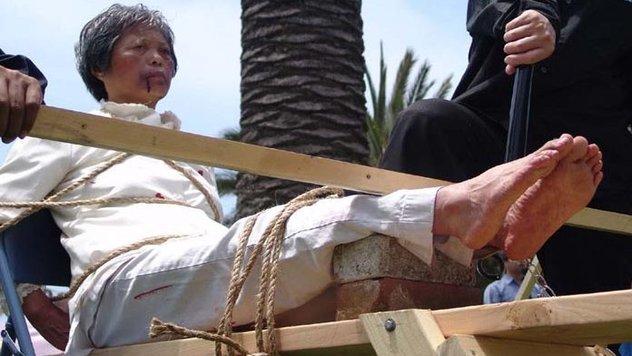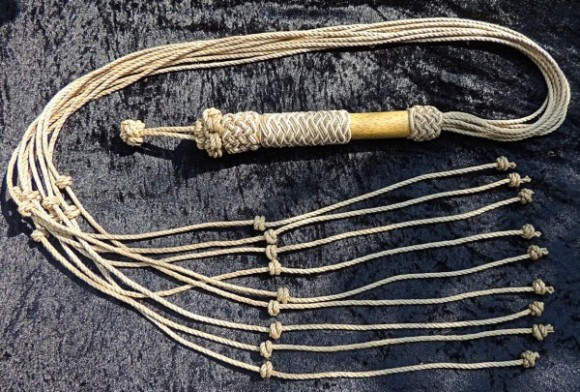 Humans
Humans  Humans
Humans  Animals
Animals 10 Animals That Humiliated and Harmed Historical Leaders
 History
History 10 Most Influential Protests in Modern History
 Creepy
Creepy 10 More Representations of Death from Myth, Legend, and Folktale
 Technology
Technology 10 Scientific Breakthroughs of 2025 That’ll Change Everything
 Our World
Our World 10 Ways Icelandic Culture Makes Other Countries Look Boring
 Misconceptions
Misconceptions 10 Common Misconceptions About the Victorian Era
 Mysteries
Mysteries 10 Strange Unexplained Mysteries of 2025
 Miscellaneous
Miscellaneous 10 of History’s Most Bell-Ringing Finishing Moves
 History
History 10 Great Escapes That Ended Right Back in Captivity
 Humans
Humans 10 Everyday Human Behaviors That Are Actually Survival Instincts
 Animals
Animals 10 Animals That Humiliated and Harmed Historical Leaders
 History
History 10 Most Influential Protests in Modern History
Who's Behind Listverse?

Jamie Frater
Head Editor
Jamie founded Listverse due to an insatiable desire to share fascinating, obscure, and bizarre facts. He has been a guest speaker on numerous national radio and television stations and is a five time published author.
More About Us Creepy
Creepy 10 More Representations of Death from Myth, Legend, and Folktale
 Technology
Technology 10 Scientific Breakthroughs of 2025 That’ll Change Everything
 Our World
Our World 10 Ways Icelandic Culture Makes Other Countries Look Boring
 Misconceptions
Misconceptions 10 Common Misconceptions About the Victorian Era
 Mysteries
Mysteries 10 Strange Unexplained Mysteries of 2025
 Miscellaneous
Miscellaneous 10 of History’s Most Bell-Ringing Finishing Moves
 History
History 10 Great Escapes That Ended Right Back in Captivity
10 Gruesome Torture Devices Used in Modern Times
If someone asked you to think of torture devices, you would probably picture some crazy medieval contraption. But you probably couldn’t come up with any modern torture devices because, hey, no one really tortures anyone anymore. Right? Wrong.
10Tiger Bench

China really hates the practitioners of Falun Gong, a sort of spiritual discipline first introduced in 1992. Since the beginning, many Falun Gong followers have been brutally punished. One form of torture used on them is a device called the tiger bench. This works by placing a prisoner on a long bench with a board against their back and head. The prisoner is then tied down, so their back is secured to the board, and their feet and legs are secured to the bench. Next, bricks are placed under their feet until all the straps holding the legs down break—or the prisoner’s legs snap before the straps do.
In one case from 2002, a Ms. Wang was walking home when the police abducted her. She was tortured on the tiger bench for two days and one night while also being beaten and electrocuted. The shackles dug into her ankles so badly that her bones were visible by the end of the torture.
Along with the tiger bench, Ms. Wang was also beaten by the guards, hung naked on a wooden board so male prisoners could humiliate her, had one of her eyes burned by a cigarette, and had her ears stabbed with skewers. She eventually died in 2007, while still in police custody.
Discover some of the disturbing ways torture has been used throughout the ages with The Big Book of Pain: Torture & Punishment through History at Amazon.com!
9Hell Confinement

For Falun Gong members unfortunate enough to be caught, there is an option arguably even worse than the tiger bench: the hell confinement.
The hell confinement uses a device that includes a pair of handcuffs and a pair of foot shackles, both of which are linked to a steel rod. The rod presses against the prisoner’s back, making it nearly impossible to walk, sit, use the toilet, or even feed themselves.
Zhu Hang is a Chinese woman who knows just how cruel the practice is. After she was arrested for partaking in a Falun Gong exercise in a public park, she was taken to an undisclosed location and tortured with hell confinement. For seven days, she did not eat, barely walked, couldn’t sit, and was forced to defecate on herself until she was finally released.
8The Tucker Telephone

If you ended up in prison during the 1960s, the last place you wanted to be sent was Tucker State Prison Farm in Arkansas. In the 1960s, doctors at the prison began using a torture device on some of the more unruly prisoners that became known as the Tucker telephone.
The device worked by placing a ground wire around the big toe of a prisoner while fastening another wire, the hot wire, to the prisoner’s genitals. The telephone, which had been modified to send electric shocks, was cranked, sending electricity right to the family jewels. And sometimes, it wasn’t just a turn of the crank and done. In prison terms, a long-distance phone call meant the prisoner would be shocked repeatedly.
The Tucker telephone was finally banned in the 1970s.
7Strappado

While the strappado was used heavily during the Renaissance, it seems to have experienced a resurgence during the last century. Many people may now know it as Palestinian Hanging. This form of torture is where a prisoner is hung by their arms, which are fastened behind their head, causing the arms to be slowly wrenched from the shoulder sockets by the weight of the body. When the prisoner finally becomes so tired they cannot hold themselves upright, their bodies fall forward, and their breathing is impaired.
One of the last known cases of the United States using this form of torture was on Mandel al-Jamadi in 2003. He was arrested for allegedly being involved in making explosives and was sent to Abu Ghraib, where he died while being tortured.
6Cold Cell

The CIA has six interrogation techniques they are authorized to use, and one of them is basically torture. The cold cell is an “enhanced interrogation technique” where the prisoner is placed in front of an air conditioner unit for hours, days, and even years at a time. And the practice hasn’t just been used by the CIA.
The first recorded use of a cold cell took place in 1961 when guards at Parchman, Mississippi’s state penitentiary doused detained civil rights activists with fire hoses and then turned the air conditioning system on full blast for three days.
Vhuen Van Tai probably had it the worst, though. Tai was the highest-ranking Viet Cong officer captured during the Vietnam War. When the CIA got a hold of him, they placed him in a tiny, white, windowless room and turned the AC on full blast for four straight years.
Lock yourself into a fascinating read with A Question of Torture: CIA Interrogation, from the Cold War to the War on Terror at Amazon.com!
5Shuanggui

In China, shuanggui is a form of extralegal detention used by the Communist party on people suspected of corruption. In reality, though, it seems like anyone could end up being tortured in a shuanggui.
Inside these detention centers, any form of torture is possible. One man, Yu Qiyi, a 42-year-old chief engineer at a state-owned investment firm was held in a shuanggui for 38 days, being repeatedly dunked in ice-cold water until he was eventually pronounced dead. Pictures of the man’s body also show large bruise marks and heavy scarring all over his body. There is still no evidence as to why he was taken into custody in the first place.
Qiyi’s case isn’t abnormal either. Many people have been held in shuanggui for long periods of time, with reports of people being tortured with physical manipulation, sleep deprivation, simulated drowning (or actual drowning, as above), beatings, burnings, and electrocutions.
4The German Chair

Syria has been locked in civil war for a long time, and with war comes torture. One form of torture often used by the Syrian government against the rebels is called the German chair. When a detainee is captured, they are placed in a metal chair. Their legs and arms are secured to the metal seat while the back of the chair is pulled back and down toward the ground. This causes severe stress on the spine, neck, and other limbs, often causing permanent damage. Basically, if your back doesn’t break, you are more than human.
Joseph Hallit knows the German chair all too well. In 1992, Syrian forces nabbed Hallit just after he had obtained his medical degree from the University of Damascus. He was kept in solitary confinement for four years, and for another four, he was tortured.
The most severe brutality he endured was the German chair. He says his flesh was torn so deeply from being stretched that he could see the nerves. To this day, he still has 3-centimeter (1.2 in) wide scars on both his arms from the torturous stretching.
3Cat O’ Nine Tails

Known simply as the cat, the cat o’ nine tails is a truly horrifying torture device. Essentially a multi-tailed whip, its “claws” can inflict vicious parallel wounds. Sometimes little metal balls with spikes are even added to the ends of the cords to make it even more excruciating.
While use of the cat dates back to Ancient Egypt, it is still used as a form of punishment in Trinidad and Tobago, even after the Inter-American Court of Human Rights ordered the country to pay a convicted rapist $50,000 after whipping him with the device. Since then, the use of the cat has fallen out of favor—but some people are calling for the country to bring it back for use on crooked politicians.
Oh, and “letting the cat of the bag” gets its origins from pulling the cat o’ nine tails out of its bag before whipping someone.
2Waterboarding

Waterboarding is a simple yet effective form of water torture. Here the victim is tied to a table with their legs elevated and a cloth covering their face. Water is then poured over the cloth for up to 60 seconds at a time, with the person only being allowed to breathe for a few seconds in between. The torture causes suffocation and a sense of drowning.
The technique was first documented in the 15th century and was a common method to induce confessions. Ed Peters, a historian at the University of Pennsylvania, states that people viewed it more or less as we view a cross-examination today. If anything, the Inquisitors “were more careful about it” than others of their time. During the Inquisition, a doctor’s presence was required during interrogations. Not that it made the experience any more pleasant for the victim, of course.
In the 1800s, the practice was banned in many countries around the world. It wasn’t until the 20th century that a resurgence of waterboarding began. It was used by the Japanese in World War II, by U.S. troops in the Philippines, and by the French in Algeria, to name a few. Evidence of its use on U.S. soil is scarce, but it does exist. In 1983, Texas Sheriff James Parker was charged, along with three deputies, for handcuffing prisoners to chairs, placing towels over their faces, and pouring water on the cloth until they gave what the officers considered confessions. The sheriff and his deputies were all convicted and sentenced to four years in prison.
1White Torture

White torture may be the worst kind of torture. It is a form of emotional and physiological torture. Instead of beating the person, electrocuting them, or keeping them in a small box, they are tormented with sensory deprivation and isolation.
White torture is all too familiar for Amir Abbas Fakhravar, who is said to be the first person to be tortured this way by the Iranian government. According to Amnesty International, “the cells had no windows, and everything was entirely colored creamy white. The meal was white rice on a white paper plate. If he wanted to use the toilet, he had to put a white slip of paper under the door of the cell to alert guards who reportedly had footwear designed to muffle any sound. Fakhravar was forbidden to talk to anyone.”
Ebrahim Nabavi, another journalist who was given the treatment said the worst part of the white torture is never being “free” even after being released.
I am still unemployed. Let’s talk about that.








